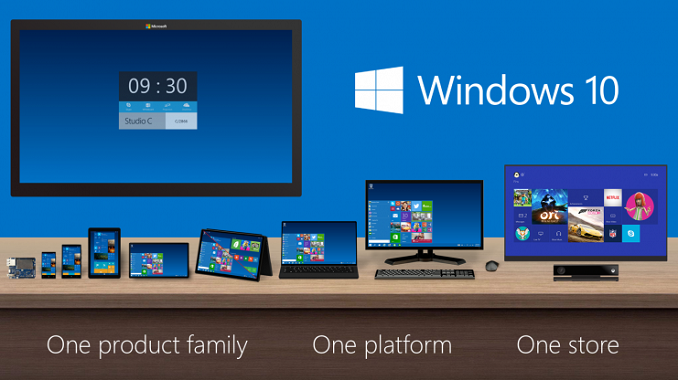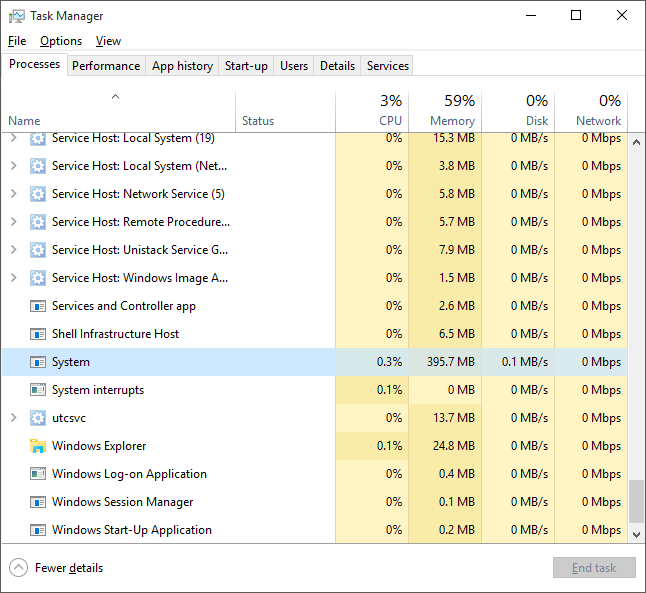Windows 10 Insider Preview Continues: Build 10525 Released To Fast Ring
by Brett Howse on August 18, 2015 7:15 PM EST- Posted in
- Operating Systems
- Microsoft
- Windows 10

Even though Windows 10 is now officially launched, the Insider Program is going to continue. People that have joined the preview program now have a new build of Windows 10 available to them. Build 10525 is the first build released since 10240 was shipped out in July, and the first build since the July 29th launch of Windows 10.
One of the things that has already struck me with Windows 10 is just how quickly it is being iterated even after launch. Small things are constantly being fixed, and because many of them are now being done through the Windows Store, large updates through Windows Update which require a computer restart are not always needed. However Windows Update has been busy too, with three cumulative updates rolled out in the last couple of weeks. It goes to show two things. Windows as a Service is happening, and Windows 10 when it shipped was not complete. While I think that’s kind of the new normal now, with the software never being complete and always being updated, hopefully they will pull back the pace of Windows Updates in the near future since not everyone wants to deal with a system restart every couple of days.
So let’s get on to the changes. First of all there is now the ability to customize the colors for Start, Action Center, Taskbar, and Title bars. People like to customize and this is a great addition. Hopefully these kinds of changes can be saved as themes like in the old days of Windows, and that would allow people to share their experiences. In a world of social, this seems like it can’t not happen.
The only other major change listed is improvements to the Memory Manager. In fact, it is not even new to this build, although they could have tweaked it with 10525. Memory Manager now includes the ability to compress pages if there is memory pressure. This is done as a first step rather than instantly write them to disk when there is pressure on memory, and this change improves responsiveness since it is quicker to decompress when necessary than access the disk to retrieve the pages necessary. By reducing the amount of memory used per process, Windows 10 can keep more active programs in main memory which is going to be a big help on devices without a lot of system memory. The minimum memory for Windows 10 is 1 GB on 32-bit and 2 GB on 64-bit, and we’ve seen some low cost devices shipping with the minimum, so this should be a nice improvement for them in the seat of the pants feel. What it does mean is that the System process is going to seem like it’s using more memory than past releases, since it is keeping these compressed pages in check.
In an odd twist, there are some known issues with the new build. I had wondered how much of this would happen post launch, since the last couple of builds released before launch were all about bug fixes, but it appears that Microsoft is OK with sending out less than 100% functional code to the Fast Ring. Mobile Hotspots don’t work in this build, video playback has an issue which requires an update to the Film & TV app, and optional language packs will not be available on this initial launch, but should be available later in the week.
What’s actually the most telling about how Windows 10 is being developed is that the Mobile Hotspot bug is exactly the same one as the most recent Windows 10 Mobile build released to phones last week. They really are the same code base now. It actually is not going to be a bug that affects a lot of people on Windows 10 since most devices don’t have cellular connectivity anyway, unlike the Mobile build, but if you do use this you better skip the Fast Ring on this one.
If you want to give this build a try, head over to https://insider.windows.com/ and sign up, and then go to settings and set your device to Fast Ring in Windows 10.
And, as an update, I am still finishing up the final touches on our Windows 10 Review so stay tuned for that.
Source: Windows Blog












47 Comments
View All Comments
casperes1996 - Tuesday, August 18, 2015 - link
Good for Windows! Now it's got the memory compression tech OS X Mavericks did!(Before you jump on me, whilst I prefer OS X, I also have Windows 10, and I actually really like the new Microsoft)
Stephen Barrett - Tuesday, August 18, 2015 - link
Windows 8 beat OS X to introduce memory deduplication. OS X does not do memory compression (to my knowledge). So windows has led OS X here not trailed itAlexvrb - Tuesday, August 18, 2015 - link
Yeah Win8 introduced a lot of positive memory management changes. 10 continues this trend. Once again an Apple fan has declared that such-and-such feature which is new to Apple, is revolutionary and anyone else that has it is a copycat. :PSamus - Wednesday, August 19, 2015 - link
Memory compression was less of an issue for PC's until now, where many PC's (i.e. tablets) are not upgradable.Apple has had this issue for years with models such as the Macbook Air, which has historically shipped with inadequate capacity, non-upgradable memory. This is also Apple's best-selling model.
Simply put, in order for Apple to guarantee 2008-2009 Macbook Air models with 1GB of non-upgradable RAM could run Mavericks, they HAD to introduce memory compression technology. This isn't to say it's a good thing, either. The memory compression technology has a huge performance hit and most people find OSX 10.7/10.8 performs around twice as fast on the same hardware when running older Macbook Air/Macbook Pro models with 2GB or less.
This is in fact completely the opposite of Microsofts' approach. Since the introduction of Windows Vista 10 years ago, Windows 7, Windows 8, and Windows 10 have consistently become more lightweight and less demanding on hardware. Windows 7, introduced in 2009, could still run quite well on a 10 year old Pentium 3, and Windows 10, introduced last month, runs quite well on a 14 year old Pentium M.
Microsoft is trying to get everyone on the later versions of Windows much the same as Apple has been trying with OSX, but the companies have completely different agenda's. Apple's is to sell hardware. Microsoft's is to sell services. Neither company plans to profit much from operating system sales (although Microsoft unquestionably profits more, selling around 100 copies of Windows for every copy of OSX sold, at 3-4 times the retail price)
casperes1996 - Wednesday, August 19, 2015 - link
OS X is a feature rich OS, with many background tasks starting from the get-go. Memory compression can't hurt, since it doesn't start compressing, before it is needed. If you prefer Windows, then you enjoy that, but that doesn't make OS X less great. Each operating system has different strengths and weaknesses, and if people don't like how Mavericks, Yosemite, and El Capitan runs on their machine, they can revert to an older OS, install Windows or any other OS.name99 - Wednesday, August 19, 2015 - link
Apple NEVER shipped MacBook Air's with 1GB of RAM.https://en.wikipedia.org/wiki/MacBook_Air#Specific...
Your other claims ("most people find OSX 10.7/10.8 performs around twice as fast on the same hardware") are equally ungrounded in any sort of reality.
As for memory deduplication, let's quote ArsTechnica:
http://arstechnica.com/information-technology/2011...
"The gains this produces in normal day-to-day desktop usage may not be enormous. In demonstrations at BUILD last month, forcing a scan of memory to share anything possible only freed a few MB"
Memory deduplication makes sense for Windows (and Linux) because it can substantially improve virtualization of VMs running identical OSs. But this scenario is basically non-existent on OSX. Few people run VMs, and those that do tend to run different OSs in the VMs (maybe one copy of Windows, and one copy of an older OSX for developer testing).
In other words Apple did not add this feature not because they're too stupid to do so, but because it is pretty much irrelevant to their users.
Those aspects of dedup that ARE relevant to OSX (shared libraries, copy-on-write, shared zero page) have of course been there since the Mach days.
Knighttyme - Monday, August 24, 2015 - link
I've used every version of Windows on every type of PC, and I've owned Apple Pads, Phones and computers going back to Apple 6502 computers.Apple has beautiful hardware designed to maximize the users experience with form and finish. This helps entice the user into accepting the premium cost along with the specter of it ongoing incompatibility of its hardware (don't scoff, almost every mac is running Windows). Apple's hardware products are perfectly matched to it's sometimes buggy (don't forget Mavericks) OS.
Meanwhile Microsoft (a 90% software company) has made its, yes at times buggy OS run on every type of PC made by both good and bad hardware vendors and on existing yet to have been invented hardware with 3rd party drivers, while keeping it cost reasonable.
The path Microsoft has taken is the more inventive one and by far (many fold) and more challenging with mostly successful results.
Writing an OS on your own controlled hardware is impressive... but when compared to the span and depth of varying products Windows runs on... its not even in the same realm.
Sorry to add in one more simple empirical evaluation... CPU to CPU and Gb to Gb, Apples to Apples (pun intended), PCs run faster than MACs
casperes1996 - Wednesday, August 19, 2015 - link
Apple fan, yes. Microsoft hater, no. OS X has indeed done memory compression since 10.9, look it up. I am not saying that OS X is leading in this field, I was just making a silly remark. The two OS's handle memory quite differently, and what works best depends on a lot of factors. To each their own. I did not come with hateful statement, just an attempt at some silly humour, so if we could all A) Do our research, and B) Be friendly and kind instead of attacking the first person we see to disagree with us? This is a general statment, and doesn't just pertain to this, because I see a lot of negativity in these comments, and attacks on people aren't uncommon. If I say something wrong, by all means, do correct me, but don't call me a dumb cunt for making mistakes.PS. Source for saying the memory compression thing regarding Mavericks and up: The Apple WWDC keynote.
Alexvrb - Wednesday, August 19, 2015 - link
I never stated OS X didn't do memory compression. Win 8 and 10 have very good memory handling. They run well on low-memory systems as a result. Maybe I should have clarified my other statement further: You implied that they copied Mavericks - "has the tech Mavericks did". Memory compression is not new. Apple implemented it, and MS implemented it - the tech and the credit doesn't really belong to either. However the more recent implementations are better and smarter - not sure how CPU-intensive they are.Flunk - Wednesday, August 19, 2015 - link
That's mostly because OS X is such a memory hog. Try running it without at least 4GB of RAM, it's glacial. Even 4GB is barely enough.